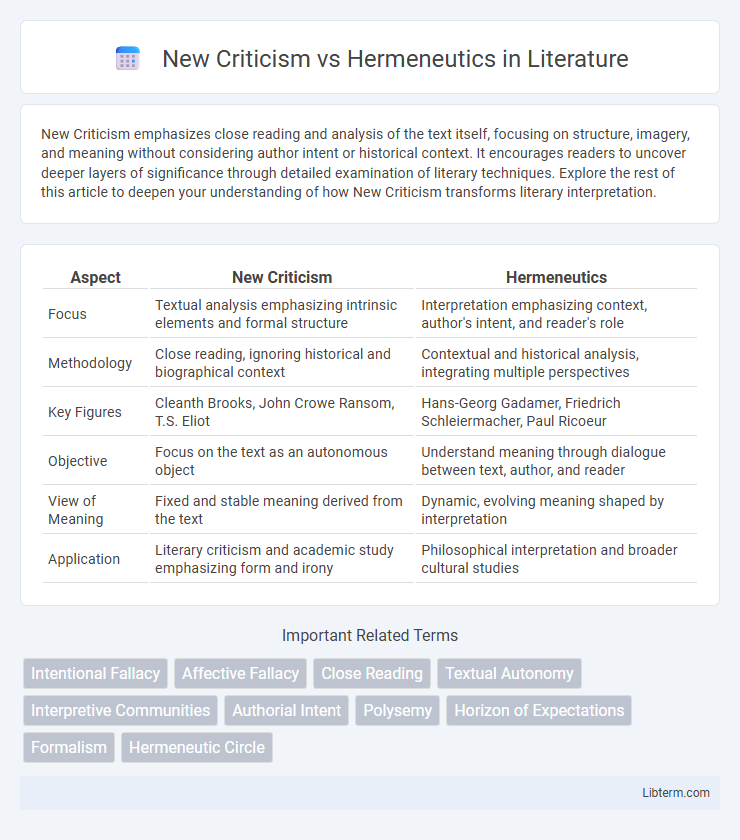New Criticism emphasizes close reading and analysis of the text itself, focusing on structure, imagery, and meaning without considering author intent or historical context. It encourages readers to uncover deeper layers of significance through detailed examination of literary techniques. Explore the rest of this article to deepen your understanding of how New Criticism transforms literary interpretation.
Table of Comparison
| Aspect | New Criticism | Hermeneutics |
|---|---|---|
| Focus | Textual analysis emphasizing intrinsic elements and formal structure | Interpretation emphasizing context, author's intent, and reader's role |
| Methodology | Close reading, ignoring historical and biographical context | Contextual and historical analysis, integrating multiple perspectives |
| Key Figures | Cleanth Brooks, John Crowe Ransom, T.S. Eliot | Hans-Georg Gadamer, Friedrich Schleiermacher, Paul Ricoeur |
| Objective | Focus on the text as an autonomous object | Understand meaning through dialogue between text, author, and reader |
| View of Meaning | Fixed and stable meaning derived from the text | Dynamic, evolving meaning shaped by interpretation |
| Application | Literary criticism and academic study emphasizing form and irony | Philosophical interpretation and broader cultural studies |
Introduction to New Criticism and Hermeneutics
New Criticism emphasizes close reading and intrinsic analysis of the text, focusing on its formal elements such as imagery, symbols, and structure without considering external contexts like author intention or historical background. Hermeneutics, rooted in philosophical traditions, explores the interpretation of texts by understanding meaning through context, author perspective, and reader response, emphasizing the dynamic interaction between text and interpreter. Both approaches offer distinct methodologies for literary analysis, with New Criticism advocating for objective analysis of the text itself and Hermeneutics prioritizing interpretative frameworks shaped by cultural and historical factors.
Historical Origins and Development
New Criticism emerged in the early 20th century, primarily in the United States, emphasizing close reading and the text itself as an autonomous entity, free from historical or biographical context. Hermeneutics, with roots tracing back to ancient philosophy and significantly developed in the 19th century by thinkers like Friedrich Schleiermacher and Hans-Georg Gadamer, focuses on the interpretation and understanding of texts through historical, cultural, and linguistic contexts. The development of New Criticism was a reaction against historicism and biographical criticism, while hermeneutics evolved to address the dynamic relationship between the reader and text across time.
Core Principles of New Criticism
New Criticism centers on close reading and the text itself, emphasizing the importance of analyzing the internal features such as imagery, symbolism, and structure without considering external contexts like author intent or historical background. It advocates for the autonomy of the text, treating literary works as self-contained entities with intrinsic meanings. This approach contrasts with Hermeneutics, which prioritizes interpretation shaped by historical, cultural, and authorial contexts.
Foundational Concepts in Hermeneutics
Hermeneutics centers on the foundational concepts of interpretation, emphasizing the historical context, authorial intent, and the dialogical relationship between text and reader to uncover layered meanings. Unlike New Criticism, which prioritizes the text's internal structures and formal elements, Hermeneutics incorporates the dynamic process of understanding influenced by cultural and linguistic backgrounds. Core principles include the hermeneutic circle, where comprehension evolves through iterative interaction between parts and the whole, and the fusion of horizons, blending the interpreter's perspective with the original context.
Textual Analysis: Close Reading vs Interpretation
New Criticism emphasizes close reading, focusing on the text's form, language, and intrinsic meanings without considering historical or authorial context. Hermeneutics prioritizes interpretation, exploring the text's deeper significance through philosophical, cultural, and contextual analysis. Close reading dissects literary devices and structure, while hermeneutic interpretation seeks to uncover broader meanings and reader-response dynamics.
Role of Authorial Intent
New Criticism emphasizes the autonomy of the text, rejecting authorial intent as irrelevant to interpretation, focusing instead on close reading and intrinsic elements like imagery, structure, and language. Hermeneutics prioritizes understanding the author's intended meaning by considering historical context, cultural background, and the communicative act between author and reader. While New Criticism treats the text as self-contained, Hermeneutics views authorial intent as essential to uncovering layered meanings and bridging gaps between text and interpretation.
Reader’s Role in Meaning-Making
New Criticism emphasizes the text's autonomy and advocates for close reading, minimizing the reader's personal response or context in meaning-making. Hermeneutics highlights the active role of the reader, asserting that interpretation arises from the dynamic interaction between the text and the reader's historical, cultural, and subjective perspectives. The reader's role in Hermeneutics is essential, as understanding evolves through dialogue and the fusion of horizons between text and interpreter.
Objectivity in Literary Criticism
New Criticism emphasizes objectivity by focusing on the text itself, analyzing literary elements such as imagery, structure, and symbolism without considering author intent or historical context. Hermeneutics, however, prioritizes the interpretative process, acknowledging the reader's role and cultural context, which introduces subjectivity into literary criticism. While New Criticism seeks fixed meanings within the text, Hermeneutics embraces the fluidity of meaning shaped by interaction between the text and the reader.
Strengths and Limitations of Each Approach
New Criticism emphasizes close reading and textual analysis, revealing intricate details and inherent meanings within literary works, but it often neglects historical and authorial contexts. Hermeneutics excels in interpreting texts through historical, cultural, and existential frameworks, enriching understanding with contextual depth, yet it risks subjective bias and over-interpretation. Both approaches provide valuable insights: New Criticism offers precise, text-centered clarity, while Hermeneutics fosters broader, context-sensitive comprehension.
Contemporary Relevance and Applications
New Criticism emphasizes close reading and textual autonomy, fostering precise literary analysis crucial in contemporary academic settings and digital humanities projects. Hermeneutics, with its focus on interpretative contexts and reader experience, addresses modern interdisciplinary studies and cultural analysis, enriching understandings of diverse narratives. Both methodologies influence contemporary literary criticism, education, and digital content interpretation, reflecting evolving perspectives on meaning and textual engagement.
New Criticism Infographic

 libterm.com
libterm.com